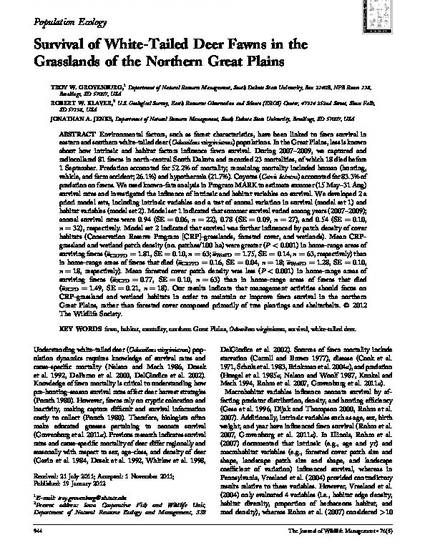
Article
Survival of white-tailed deer fawns in the grasslands of the northern Great Plains
The Journal of Wildlife Management
(2012)
Abstract
Environmental factors, such as forest characteristics, have been linked to fawn survival in eastern and southern white-tailed deer (Odocoileus virginianus) populations. In the Great Plains, less is known about how intrinsic and habitat factors influence fawn survival. During 2007–2009, we captured and radiocollared 81 fawns in north-central South Dakota and recorded 23 mortalities, of which 18 died before 1 September. Predation accounted for 52.2% of mortality; remaining mortality included human (hunting, vehicle, and farm accident; 26.1%) and hypothermia (21.7%). Coyotes (Canis latrans) accounted for 83.3% of predation on fawns. We used known-fate analysis in Program MARK to estimate summer (15 May–31 Aug) survival rates and investigated the influence of intrinsic and habitat variables on survival. We developed 2 a priori model sets, including intrinsic variables and a test of annual variation in survival (model set 1) and habitat variables (model set 2). Model set 1 indicated that summer survival varied among years (2007–2009); annual survival rates were 0.94 (SE = 0.06, n = 22), 0.78 (SE = 0.09, n = 27), and 0.54 (SE = 0.10, n = 32), respectively. Model set 2 indicated that survival was further influenced by patch density of cover habitats (Conservation Reserve Program [CRP]-grasslands, forested cover, and wetlands). Mean CRP-grassland and wetland patch density (no. patches/100 ha) were greater (P < 0.001) in home-range areas of surviving fawns ( = 1.81, SE = 0.10, n = 63; = 1.75, SE = 0.14, n = 63, respectively) than in home-range areas of fawns that died ( = 0.16, SE = 0.04, n = 18; = 1.28, SE = 0.10, n = 18, respectively). Mean forested cover patch density was less (P < 0.001) in home-range areas of surviving fawns ( = 0.77, SE = 0.10, n = 63) than in home-range areas of fawns that died ( = 1.49, SE = 0.21, n = 18). Our results indicate that management activities should focus on CRP-grassland and wetland habitats in order to maintain or improve fawn survival in the northern Great Plains, rather than forested cover composed primarily of tree plantings and shelterbelts.
Keywords
- fawn,
- habitat,
- mortality,
- northern Great Plains,
- Odocoileus virginianus,
- survival,
- white-tailed deer
Disciplines
Publication Date
July, 2012
DOI
10.1002/jwmg.339
Publisher Statement
Works produced by employees of the U.S. Government as part of their official duties are not copyrighted within the U.S. The content of this document is not copyrighted.
Citation Information
Troy W. Grovenburg, Robert W. Klaver and Jonathan A. Jenks. "Survival of white-tailed deer fawns in the grasslands of the northern Great Plains" The Journal of Wildlife Management Vol. 76 Iss. 5 (2012) p. 944 - 956 Available at: http://works.bepress.com/robert-klaver/37/
